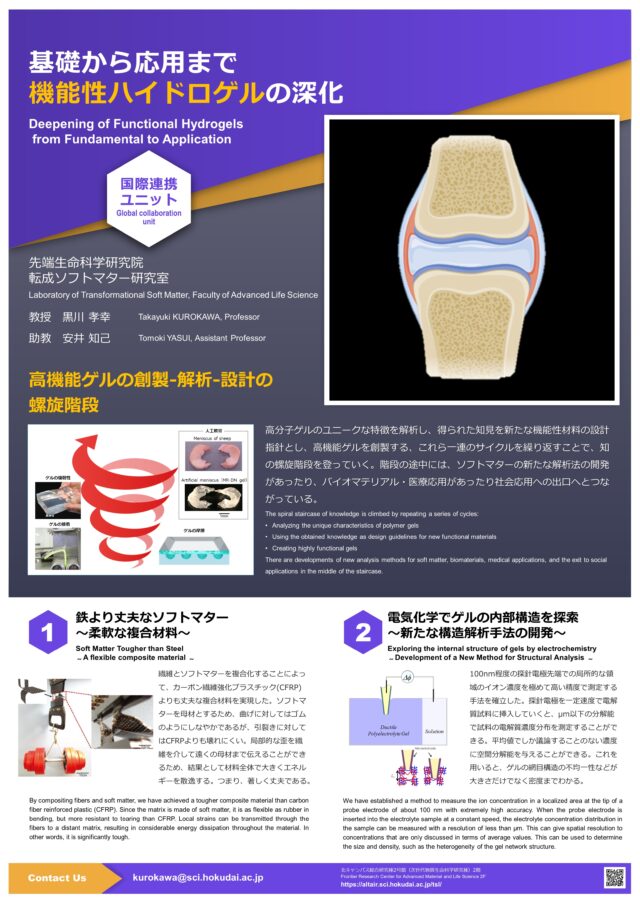Laboratory of Transformational Soft Matter
- Research Theme
- Understanding Friction Using Gels as a Model / Analysis of the Internal Structure of Gels by Donnan Potential Measurements / Creation of Soft Composites with Unique Mechanical Properties / Biomaterials Investigation and Development
- Research Keywords
Polymer gel, Double network gel, Friction of gel, Artificial cartilage, Cell culture substrate, Soft composite material, Adsorption and adhesion, Donnan potential
Staff
-
KUROKAWA Takayuki Professor
-
YASUI Tomoki Assistant Professor
-
TSUNODA Katsuhiko Visiting Professor
-
SARUWATARI Yoshiyuki Visiting Associate Professor
Overview of Research and Education
We create functional polymer hydrogels, understand the mechanism of their functions, and use the knowledge obtained as a guideline for designing new functional gels. By repeating the cycle of creating even more highly functional materials, we can enhance the usefulness of polymer gel materials as if climbing a spiral staircase. In the middle of the spiral staircase, some technologies lead to biomaterials and new physical property measurement methods, which lead to the exit for “real world” applications. In our laboratory, you can learn about topics ranging from fundemental basics of materials to cutting-edge applications through gel research. Examples of research themes that traverse this range include understanding fundamentals of friction, wear, and fatigue; developing double-network gels with toughness exceeding natural cartilage; and creation and physical property analysis of gels for therapeutic use. The culmination in this work leads to the development of tough soft composite materials with the potential for applied use, and a real impact on society.
Laboratory of Transformational Soft Matter (pdf)
Charge
- Charge (US):
School of Science, Biological Science course (Macromolecular Functions), Core Laboratories - Charge (GS):
Graduate School of Life Science, Division of Soft Matter, Soft Matter Materials Science
Contact
- Address
- 〒001-0021
Frontier Research Center for Advanced Material and Life Science 2F,
Kita 21 Nishi 11, Sapporo - Phone
- 011-706-9018
- Fax
- 011-706-9018
- kurokawa*sci.hokudai.ac.jp (Please replace*with @ when sending e-mail.)
Representative Publications
T. Nishimura, H. Guo, Y. Katsuyama, M. Yoshida, J. P. Gong, T. Kurokawa*, “Spatial Analysis of the Damage Zone in Double Network Hydrogel Using the Microelectrode Technique,” Macromolecules, 57(4), 1502-1508 (2024)
Y. N. Ye, M. A. Haque, A. Inoue, Y. Katsuyama, T. Kurokawa*, J. P. Gong*, “Flower-like Photonic Hydrogel with Superstructure Induced via Modulated Shear Field,” ACS MACRO LETTERS, 10(6), 708-713 (2021)
R. Zhu, H. Yang, W. Cui, L. Fadillah, T. Huang, Z. Xiong, C. Tang, D. Kowalski, S. Kitano, C. Zhu, D. R. King*, T. Kurokawa, Y. Aoki, H. Habazaki, “High strength hydrogels enable dendrite-free Zn metal anodes and high-capacity Zn-MnO2 batteries via a modified mechanical suppression effect,” Journal of Materials Chemistry A, 10(6), 3122-3133 (2022)
T. Nishimura, H. Guo, R. Kiyama, Y. Katsuyama, J. P. Gong, T. Kurokawa*, “In Situ Evaluation of the Polymer Concentration Distribution of Microphase-Separated Polyelectrolyte Hydrogels by the Microelectrode Technique,” Macromolecules, 54(23), 10776-10785 (2021)
S. Hirayama, T. Kurokawa*, J. P. Gong, “Non-Linear Rheological Study of Hydrogel Sliding Friction in Water and Concentrated Hyaluronan Solution,” Tribology International, 147, 106270 (7 pages) (2020).
H. Guo, W. Hong, T. Kurokawa, T. Matsuda, Z. L. Wu, T. Nakajima, M. Takahata, T. L. Sun, P. Rao, J. P. Gong, “Internal Damage Evolution in Double-Network Hydrogels Studied by Microelectrode Technique,” Macromolecules, 52(18), 7114-7122 (2019).
W. Cui, D. R. King, Y. Huang, L. Chen, T. L. Sun, Y. Guo, Y. Saruwatari, C. Y. Hui, T. Kurokawa, Jian Ping Gong*, “Fiber-reinforced Viscoelastomers Show Extraordinary Crack Resistance that Exceeds Metals,” Advanced Materials, 32(31), 1907180 (9 pages) (2020).
Y. Huang, D. R. King, W. Cui, T. L. Sun, H. Guo, T. Kurokawa, H. R. Brown, C.Y. Hui, J. P. Gong, “Superior Fracture Resistance of Fiber Reinforced Polyampholyte Hydrogels Achieved by Extraordinarily Large Energy-dissipative Process Zones,” Journal of Materials Chemistry A, 7(22), 13431-13440 (2019).
D. R. King*, T. Okumura, R. Takahashi, T. Kurokawa, Gong, J. P.* “Macroscale Double Networks: Design Criteria for Optimizing Strength and Toughness.” ACS Applied Materials & Interfaces. 2019, 11 (38): 35343-35353.
